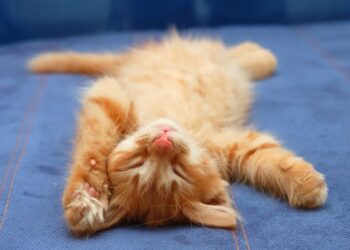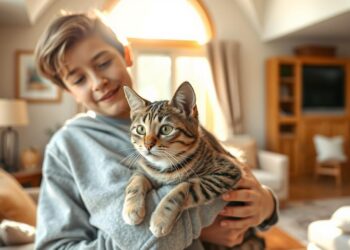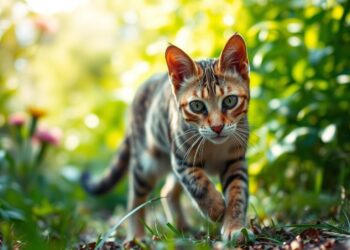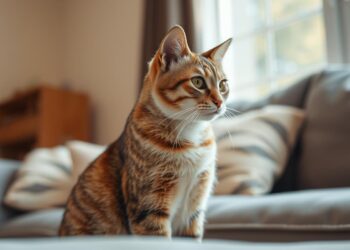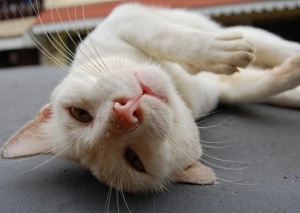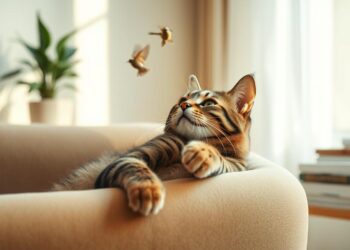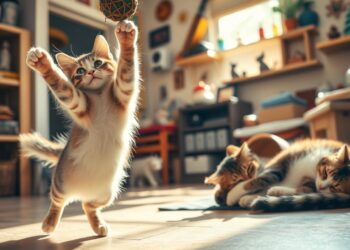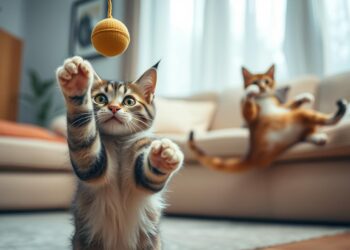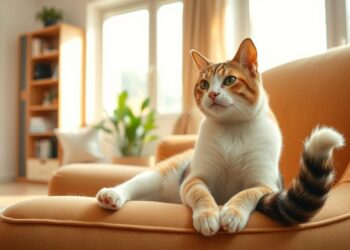Have you ever watched your feline friend exhibit a puzzling behavior and wondered what was going through their mind? Cats often display actions that seem bizarre or inexplicable to their human companions.
Understanding these actions can deepen the bond between you and your beloved pet, revealing the intricacies of feline communication and psychology. From the midnight zoomies to chattering at birds, these behaviors are rooted in their evolutionary history and natural instincts.
This comprehensive guide will explore eight of the most common yet puzzling behaviors exhibited by domestic cats, shedding light on the science and instincts behind each one, and helping you gain a deeper appreciation for your cat’s unique personality.
Understanding Your Feline Friend’s Quirks
Our feline companions often exhibit behaviors that seem strange or inexplicable, prompting us to delve deeper into the underlying causes. Cats are very unique creatures, and their odd body language and strange habits are part of why we love them so much.
Why Cats Behave Strangely
Cats often display weird cat behaviors that seem odd or inexplicable to humans, but these actions typically have roots in their evolutionary history as both predators and prey animals. Many of these behaviors served important survival functions for their wild ancestors, from territorial marking to hunting techniques.
The domestication process of cats began around 10,000 years ago, much more recently than dogs, which explains why many wild behaviors remain intact in our household companions.
The Evolution of Domestic Cat Behavior
Understanding the evolutionary context of cat behaviors helps explain why domestic cats still exhibit these seemingly strange actions despite living in safe home environments. Your feline friend‘s quirks are often manifestations of deeply ingrained instincts that have been shaped over thousands of years of evolution.
| Behavior | Evolutionary Origin | Modern Manifestation |
|---|---|---|
| Territorial Marking | Claiming territory to attract mates and deter rivals | Scratching furniture or spraying urine |
| Hunting Techniques | Stalking and catching prey for survival | Playing with toys or chasing laser pointers |
| Communication Methods | Signaling to other cats through vocalizations and body language | Meowing to humans or displaying affectionate behavior |
By understanding the evolutionary history behind these behaviors, we can better appreciate our cats’ unique personalities and needs.
The Science Behind Strange Cat Behavior
Understanding the science behind strange cat behavior reveals the intricate mechanisms driving their actions. Cats communicate through a variety of methods, including vocalizations, body language, and scent marking. Many behaviors that seem strange to humans are actually sophisticated communication techniques.
Cat Communication Methods
Cats use multiple channels to convey information and express their needs. Vocalizations range from meows and purrs to hisses and growls, each serving a distinct purpose in feline communication. Body language, including postures and facial expressions, provides additional context. Scent marking, facilitated by scent glands in their faces and paws, allows cats to claim territory and create a familiar environment.
The complexity of cat communication is rooted in their evolutionary history, where effective signaling was crucial for survival. By understanding these methods, cat owners can better interpret their pets’ behaviors.
Instincts vs. Learned Behaviors
The distinction between instinctual and learned behaviors is crucial in understanding cat actions. Many strange cat behaviors are instinctual responses hardwired into feline DNA, while others are learned through experience and environmental factors. For instance, a cat’s ability to hunt is largely instinctual, whereas its preference for certain textures or tastes can be learned.
Recognizing whether a behavior is instinctual or learned helps explain why individual cats may exhibit different quirks despite sharing the same evolutionary background. This understanding can also inform strategies for managing or modifying undesirable behaviors.
Midnight Zoomies: Why Cats Go Wild at Night
The “midnight zoomies” is a term used to describe the sudden, energetic behavior cats display at night. It’s not uncommon for cat owners to witness their pets racing around the house in the late hours, a phenomenon that can be both entertaining and puzzling.
Cats are naturally crepuscular animals, meaning they are most active during twilight hours. This behavior is inherited from their wild ancestors, who hunted during these hours. As a result, domestic cats retain this instinctual activity pattern, often resulting in bursts of energy at night.
Natural Hunting Patterns
Cats’ natural hunting patterns play a significant role in their nocturnal behavior. Even though domestic cats don’t need to hunt for food, they still have the innate instinct to be active during certain times of the day. This is why your cat might be more energetic at night.
| Behavior | Reason |
|---|---|
| Midnight Zoomies | Discharging pent-up energy |
| Crepuscular Activity | Inherited from wild ancestors |
| Increased Nighttime Activity | Natural hunting instincts |
How to Channel Nighttime Energy
To manage your cat’s pent-up energy, engaging in play during the day can be beneficial. Interactive toys that simulate hunting can help expend this energy constructively. Establishing a consistent routine with dedicated play sessions can also help regulate your cat’s internal clock, potentially reducing disruptive nighttime activity.
By understanding and addressing your cat’s natural behaviors, you can create a more harmonious living environment for both you and your pet.
The Mystery of Kneading or “Making Biscuits”
One of the most endearing and mysterious behaviors cats exhibit is kneading, a trait that originates from their nursing days. Kneading, often affectionately called “making biscuits,” involves the rhythmic pushing of their paws against soft surfaces.
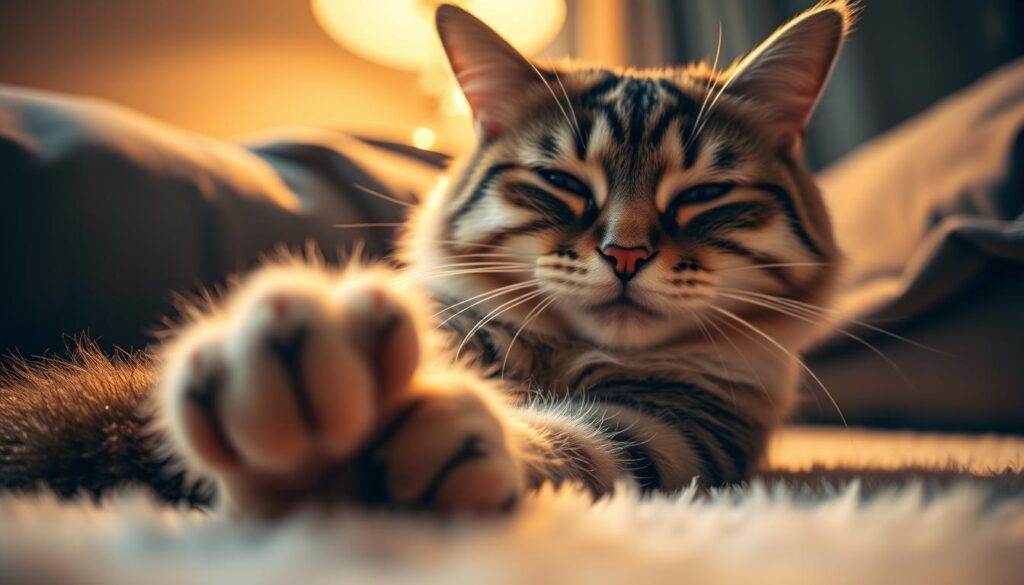
Kitten Instincts That Never Fade
This behavior starts in kittenhood when nursing kittens knead their mother’s mammary glands to stimulate milk flow—a survival mechanism that becomes ingrained in their behavioral repertoire. As cats grow, this behavior continues as a self-soothing technique that releases endorphins and creates feelings of security and contentment.
- Kneading is a leftover behavior from kittenhood, used to stimulate milk production.
- Adult cats continue kneading as a self-soothing mechanism.
- The intensity and style of kneading can reveal aspects of a kitty‘s early development and emotional state.
What Your Cat’s Kneading Style Reveals
The way your cat kneads can vary significantly and may indicate different levels of relaxation or excitement. Some cats knead with claws retracted, while others extend them. Cats that were weaned too early often display more pronounced kneading behaviors throughout their lives.
When your kitty kneads on you, they’re not only expressing comfort but also marking you with scent glands located in their paw pads—essentially claiming you as their territory.
Chattering at Birds: The Predator Within
Cats often exhibit a peculiar behavior when they spot birds, characterized by chattering or chittering sounds. This reaction is not only fascinating but also revealing of their innate predatory instincts. When your cat stares out the window, fixated on the birds in the yard, listen carefully and you’ll probably hear chirps and teeth chatters that sound almost like the noises a bird or rodent might make.
The Hunting Excitement-Frustration Response
The distinctive chattering or chittering sound cats make when watching birds through windows represents a complex emotional state combining excitement, frustration, and anticipation. Your kitty is making this noise because they cannot get to their prey—and they’re a bit frustrated. Neurologically, chattering may be an automatic jaw movement triggered when a cat’s hunting instinct is activated but cannot be fulfilled.
Other Unusual Cat Vocalizations
Beyond chattering, cats possess an extensive vocal repertoire including chirps, trills, and meows that serve different communication purposes. The intensity of chattering often correlates with how strongly a cat’s predatory drive is developed. This behavior provides a window into your kitty’s evolutionary history as an efficient predator, even in cats that have never hunted live prey. It’s a weird cat behavior that is actually a natural part of being a cat.
Some ethologists believe this vocalization might be an attempt to mimic bird sounds as a hunting strategy, though this theory remains under scientific debate. Your cat may also make chewing or biting movements with their mouth in anticipation of the kill; this is completely normal behavior, showcasing their innate predatory nature.
Obsession With Small Spaces and Boxes
Cats often exhibit a peculiar preference for small, enclosed spaces over larger, more comfortable areas. This behavior is not just a quirk; it’s rooted in their wild ancestry. By understanding the reasons behind this preference, cat owners can better appreciate their pets’ unique characteristics.
Security and Comfort Seeking
Cats’ seemingly illogical preference for squeezing into small spaces and cardboard boxes is actually a sophisticated survival strategy inherited from their wild ancestors. Small, enclosed spaces provide cats with a sense of security by protecting them from potential threats on multiple sides, reducing their vulnerability to predators. The physical sensation of being in contact with the walls of a small space creates a calming effect for cats, releasing endorphins that reduce stress and anxiety.
The “If I Fits, I Sits” Phenomenon
This behavior explains the internet phenomenon known as “if I fits, I sits,” where cats attempt to squeeze into improbably small containers regardless of their size. Some key reasons behind this behavior include:
- The need for security and comfort, driven by instinct.
- The thermal insulation provided by boxes and small spaces, helping cats conserve body heat.
- The deeply ingrained preference for enclosed spaces, a trait observed even in large wild cats like lions and tigers.
By creating accessible hiding spaces in your home, you can significantly improve your cat’s emotional well-being by providing them with security zones they can retreat to when feeling stressed.
Head Bumping and Face Rubbing Decoded
The behavior of head bumping and face rubbing in cats is a complex form of communication and affection. When your cat rams their head into you, a behavior technically called “head bunting,” it signifies that they feel safe and comfortable around you. This action is not limited to human interaction; cats also head bunt each other to create social bonds.
Scent Marking and Bonding
Cats have scent glands located on their foreheads, cheeks, and chins. When they bump or rub against you, they’re depositing their unique scent signature, effectively marking you as part of their trusted social group or territory. This behavior is a genuine display of trust and affection in the feline world, as cats only engage in this type of contact with individuals they consider safe.
Different styles of head bumping and face rubbing can indicate varying levels of affection and social bonding. In multi-cat households, these behaviors help establish a communal group scent that reduces conflict and reinforces social cohesion among feline housemates.
Different Types of Cat Greetings
When your cat approaches you and rubs their face from nose to ear on your leg, arm, or face, it’s a sign that they like you and are happy to see you. Cats have scent glands in their faces, and this rubbing action is an act of greeting and co-mingling scents with you.
| Behavior | Description | Significance |
|---|---|---|
| Head Bumping | Ramming their head into you or other cats | Creates social bonds and marks with scent |
| Face Rubbing | Rubbing face against you or objects | Deposits scent and shows affection |
Reciprocating this greeting by gently scratching your cat’s cheeks or forehead when they initiate contact can strengthen your bond and communicate in a way your cat naturally understands.
The Curious Case of Knocking Things Over
If you’ve ever shared your home with a cat, you’re likely familiar with the frustration of finding your belongings knocked off surfaces. This behavior is not only puzzling but also potentially destructive. Cats seem to have an innate tendency to bat at and knock over objects, leaving their owners to wonder why.
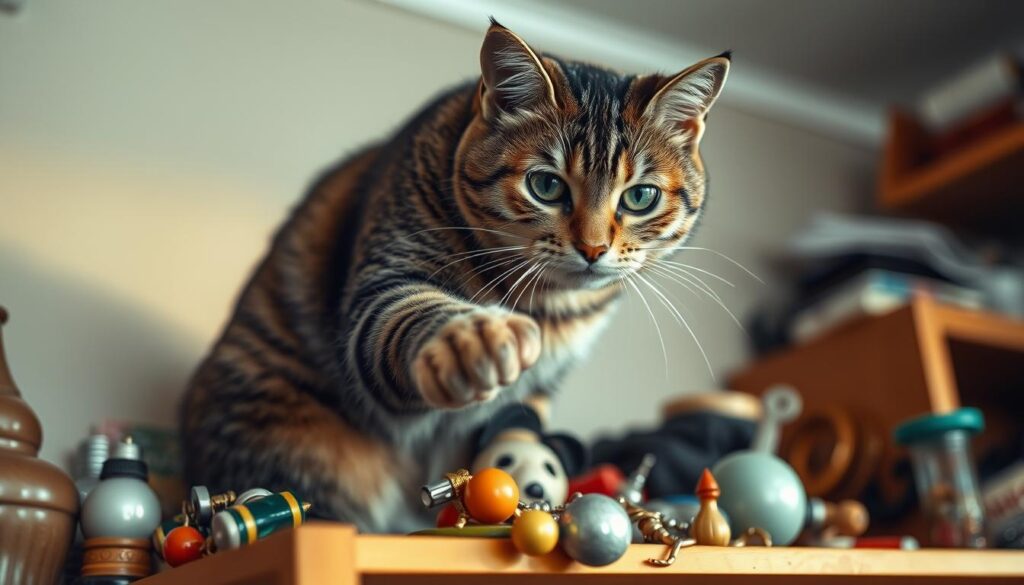
Cats’ prey drive encourages them to explore their surroundings, and their highly sensitive paws play a significant role in this behavior. By moving and touching objects, cats gather information and feedback, mimicking the way they would test potential prey in the wild.
Testing Objects and Seeking Attention
Cats use their paws to investigate objects, often knocking them over in the process. This action is driven by a combination of curiosity, attention-seeking, and hunting instinct. When cats are bored or understimulated, they may resort to knocking things over as a form of entertainment and to get attention from their human companions.
- The behavior is reinforced by the immediate reaction it elicits from owners, whether it’s cleaning up or scolding.
- Cats quickly learn that knocking things over creates a predictable response.
How to Discourage Destructive Behaviors
To discourage this behavior, cat owners can introduce new toys to engage their cat’s brain and provide regular playtime. Securing valuable items and using museum putty for decorative objects can also help. Redirecting the cat to appropriate play activities when they show interest in countertop items is another effective strategy.
| Strategy | Description | Effectiveness |
|---|---|---|
| Introduce New Toys | Engage cat’s brain with interactive toys | High |
| Secure Valuable Items | Remove temptation by securing breakables | High |
| Redirect Play | Encourage play with appropriate toys | Medium |
Unusual Water Preferences: Faucets Over Bowls
Observing cats, it’s clear that many have a strong inclination towards drinking running water. This behavior might seem puzzling, but it is rooted in their evolutionary history. In the wild, cats prefer running water because it is less likely to be contaminated with bacteria and other pathogens.
The Appeal of Running Water
The preference for running water is not just about taste; it’s also about instinct. Cats can detect subtle differences in water quality that are imperceptible to humans. Running water from a faucet is often more appealing to them than stagnant water in a bowl.
Several factors contribute to this preference:
- Many cats display a strong preference for drinking from running water sources like faucets rather than still water in bowls, a behavior rooted in evolutionary survival strategies.
- In the wild, running water is typically safer and contains fewer pathogens than stagnant water, creating an instinctual preference that persists in domestic cats despite clean water bowls.
- Cats can detect subtle water quality differences that humans cannot perceive, making tap water from a running faucet more appealing than water that has been sitting in a bowl.
Solutions for Picky Drinkers
For cats that are picky about their water, there are several solutions available. Pet fountains are an excellent option as they provide a constant flow of fresh water, encouraging cats to drink more and stay hydrated.
- The movement and sound of running water naturally attracts cats’ attention, as their hunting instincts are triggered by motion and their sensitive whiskers can better detect water without getting fully wet.
- Many kitties avoid deep water bowls because they dislike having their sensitive whiskers touch the sides, a condition sometimes called “whisker fatigue.”
- Pet fountains provide an excellent solution for picky drinkers, encouraging proper hydration which is crucial for preventing urinary tract issues common in cats.
- Make sure to place water sources away from food bowls and litter boxes, as cats instinctively avoid drinking near potential contamination sources—another evolutionary survival mechanism.
By understanding and catering to your cat’s preferences, you can ensure they stay hydrated and healthy. Consider investing in a cat water fountain to provide your kitty with fresh, running water.
The Gift-Giving Behavior: Dead Mice and “Presents”
Cats often surprise their owners with “gifts” like dead mice or birds, leaving many to wonder about the reasoning behind this behavior. This natural feline instinct is rooted in their hunting prowess and maternal instincts.
The behavior of bringing “gifts” to their human companions is one of the most misunderstood aspects of feline behavior. In the wild, mother cats teach their kittens hunting skills by bringing them prey, and domestic cats may extend this behavior to their human family members, treating them as part of their “colony.”
Showing Appreciation in Cat Language
This gift-giving behavior is a sign of affection and appreciation from your cat. By bringing you “presents,” your kitty is demonstrating its contribution to your household and showing that it values your relationship.
- Female cats typically display this behavior more frequently than males, though any cat with strong hunting instincts may bring presents to their favorite humans.
- The act of bringing “gifts” is a compliment in feline language, indicating that your cat feels comfortable and secure in its environment.
How to Respond to Unwanted Gifts
When your cat brings you a “gift,” it’s essential to respond appropriately. Avoid scolding or praising your cat, as this can create confusion or encourage more hunting. Instead, make sure to dispose of the “gift” discreetly when your cat isn’t watching.
To minimize gift-giving, consider keeping your cat indoors, as recommended by the ASPCA. For indoor-outdoor cats, adding a bell to their collar can reduce successful hunting.
Sudden Mood Swings: From Purring to Biting
Feline behavior is complex, and one common phenomenon is the sudden shift from contentment to aggression. Many cats enjoy being petted until the stimulation becomes too much, especially around the base of the tail. Their attitude can change quite quickly, and once they reach their threshold, they may swat or bite to cut off the interaction.
Some cats continue to enjoy the interaction but may exhibit “play nipping” or “love bites” due to excitement or arousal. This behavior is likely a response to the thrill of hunting or playing. Understanding these behaviors is crucial for maintaining a harmonious relationship with your cat.
Overstimulation and Sensory Thresholds
The phenomenon of a cat transitioning rapidly from contentment to aggression is often referred to as “petting-induced aggression.” This behavior is rooted in sensory processing and stimulation thresholds. Unlike humans, cats have neurological limits to how much tactile stimulation they can process before becoming overwhelmed.
- The neurological limits of cats mean they can become overwhelmed by excessive petting or stimulation.
- When a cat reaches this threshold, their nervous system triggers a defensive response, manifesting as swatting, biting, or sudden withdrawal.
- Learning to recognize subtle warning signs such as tail twitching, skin rippling, or dilated pupils is essential for harmonious human-cat relationships.
Reading Your Cat’s Body Language
Each cat has a unique tolerance level and preferred petting style. Some enjoy lengthy sessions, while others prefer brief, gentle interactions. The transition from purring to biting doesn’t indicate that your kitty is being “mean” or “moody”; it’s a communication method signaling they’ve reached their comfort limit.
To build trust and prevent negative associations with handling, make sure to respect these boundaries by allowing your cat to initiate and terminate interactions. By doing so, you can foster a more positive and understanding relationship with your feline companion.
When Strange Cat Behavior Signals Health Issues
Cat owners often notice unusual behaviors in their pets, some of which can be indicative of health concerns. While many strange cat behaviors are normal expressions of feline instinct, certain changes can serve as important warning signs of underlying health conditions.
Behavioral Changes That Warrant Veterinary Attention
Sudden alterations in litter box habits, grooming patterns, vocalization frequency, or activity levels often indicate physical discomfort or illness requiring veterinary attention. Common health issues that manifest through behavioral changes include urinary tract infections, thyroid disorders, dental disease, arthritis, and cognitive dysfunction in senior cats.
- Behaviors that develop abruptly or occur with unusual intensity warrant immediate veterinary consultation.
- Monitoring your feline companion’s behavior patterns regularly is crucial, as cats instinctively hide signs of illness until conditions become advanced.
The Difference Between Quirky and Concerning
Distinguishing between quirky personality traits and concerning symptoms requires understanding your cat’s normal behavioral baseline and recognizing significant deviations. Maintaining detailed observations about behavioral changes to share with your veterinarian can significantly improve diagnostic accuracy and treatment outcomes.
Making sure to create a stress-free home environment with predictable routines can help prevent behavior problems related to anxiety and environmental factors.
Conclusion: Embracing Your Cat’s Unique Personality
The intricate behaviors of cats, though puzzling at times, are a testament to their complex and fascinating nature. Understanding and appreciating your cat’s quirks allows you to build a stronger, more loving relationship. By respecting their natural instincts and providing appropriate outlets, you create a harmonious living environment. This mutual understanding and respect strengthen your bond, making your feline friend a cherished companion in your home.


